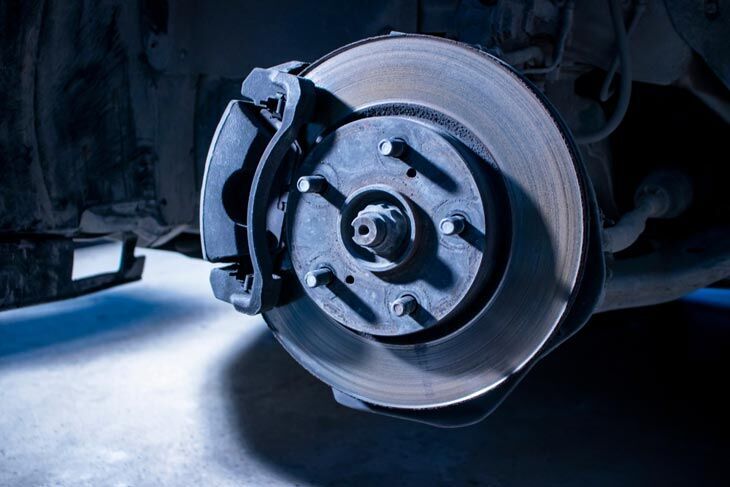Engine noise is not something out of the ordinary. But higher noise levels than usual may imply serious technical issues.
Ja kun sen möly muuttuu erittäin väkivaltaiseksi - siihen pisteeseen, että jopa erehdytään todellisen helikopterin äänet - et voi enää kohauttaa hylkäävästi ja sanoa, ei, se ei ole iso juttu!
But when your car sounds like a helicopter when accelerating, what issues are at play here?
What prompts the automobile to generate such disturbing noises? Our guidelines will explore all possible causes for such a headache.
Why Car Sounds Like A Helicopter When Accelerating?
2. Torn Brake Rotor
Similarly, tears and cracks push the brake rotors to scrape against the discs interior compartments. These instances stem from the huge space between it and the caliper as the pad breaks out.
As a result, the brake pads come in close contact with the rotors external rears, causing your vehicle to vibrate upon brake operation. In more severe cases, it might even come to a halt.
3. Inoperative Parking Brake
Determining whether the brakes malfunction or not is quite a challenge. Still, one tell-tale signal is in the air brakes, which stay engaged even while your regular brakes do not.
Worse, sometimes the brakes even engage and disengage by themselves, which calls for professional examination from experts.
4. Bad Brakes
Poor brake conditions are signified by noticeable creases on the surface, filled with crude and rust.
Those defects keep the brakes from effective rotor grips, giving the impression that all the sounds are emanating from its engine compartments. No wonder your car sounds like a helicopter !
5. Defective Wheel Bearing
6. Broken Fan Clutch Motors and Poor-Quality Tires
Defective fan blades will produce sounds like helicopters whenever you turn your car on or off, making the car accelerate or decelerate on its whim.
In the same vein, bad tires generate loud humming noises at faster speeds and only fade away once you slow down.
Such occurrences indicate a lack of proper gripping force, which might put you in danger if not fixed right away.
7. Exhaust Leak
Exhaust leak is also a possible reason. Miksi niin?
Thats because the exhaust has a separate exit other than tailpipes. But unexpected leakage might cause the black smoke to flow out of the tailpipes instead, meaning all the combustible fuel is discharged here.
All these clogging exhaust pipes generate more helicopter noise from front of car .
8. Vacuum Leak
Clicking sounds also originate from vacuum leaks, though these sounds tend to occur upon acceleration only. Other activities (such as cornering or slowing down) will not suffer from any impacts.
Still, we suggest you not leave this issue untreated for too long. Otherwise, the gasoline shortage from your engine might eventually render the car inoperable.
9. Faulty Catalytic Converter
10. Engine Problems
Alla on kolme menetelmää autojen kiusallisten helikopterin äänien korjaamiseksi.
- Menetelmä 1: Uusi siirtoesteet
- Menetelmä 2: Vaihda uusiksi pyörälaakereiksi
- Menetelmä 3: Vaihda CV -akseli
Jaamme jokaisen yksityiskohtaisiin, pienempiin vaiheisiin. Älä ohita mitään!
1. Uusia siirronesteet
Vaihteistonesteen korvaaminen on paras veto täällä. Voit joko tehdä kaiken itse tai luottaa asiantuntijatukeen palvelukeskuksesta.
Koko pyrkimys saattaa viedä melko jonkin aikaa, jos valitset entisen, joten kiinnitä itsesi kaikkiin tuleviin vaimiin.
Useimmat ajoneuvot sisältävät usein käsikirjan, jossa on yksityiskohtaiset ohjeet tällaisiin tehtäviin. Mutta jos sinun ei, tässä ovat vaiheet:
Vaihe 1. Poista pannu ja nosta auto. Kun ATF valuu, muista laittaa tarpi ja pannu sen alle.
Vaihe 2. Poista ja vaihda suodatin.
Vaihe 3 . Päästä eroon vanhasta vaihdelaatikon tiivisteestä uuden asentamiseksi. Kiinnitä sitten pannu ja täytä se ATF: llä.
Vaihe 4. Käynnistä auto ja pidä silmällä potentiaalisia vuotoja.
Vaihe 5. Puhdista sotku kissanpentuun.
2. Vaihda uusiksi pyörälaakereiksi
Vaihe 3. Poista mutterit ennen kuin käytät nostoa tämän pyörän nostamiseen. Tämä siirto antaa sinulle asianmukaisen pääsyn viallisen laakerin rakenteellisiin osiin.
Vaihe 4. Poista kilpailut, jotka vaativat usein korkean suorituskyvyn työkaluja, kuten vasara, taltta ja hioma. Tietenkin, sinun olisi pitänyt korvata käsillä valmistetut korvaavat kilpailut. Muista puhdistaa kuormakehys sisältäpäin, kun olet valmis.
Vaihe 5. Laita uudet kilpailut ja pyörälaakerit muutamalla vasaralla. Varmista, että ne ovat linjassa ja ajautuneet niin pitkälle kuin mahdollista. Tarkista myös, sijaitsevatko tiivisteaineen renkaat tasaisesti Assemblysin ulkopuolelle; Jos he eivät vielä ole, korjaa se heti.
3. Vaihda CV -akseli
Step 3. Detach The Ball Joint
Disengage the low control arm to pull the strut and remove axle joints from their bearing hubs. Do not forget to extract the low ball joint, too, to make room for these removals.
Certain ball joints also feature a self-locking cotter. Remove that (if any) using a pair of dikes.
Step 4. Install A Replacement CV Axle
With the replacement axle firmly held, lets reinsert it carefully into the gearbox to avoid destroying the transmission seals. Force it forward to ensure a proper fit.
It might take some time (and a little bit of jiggling) to shove it into the gearbox entirely, so try to be more patient.
This step requires lots of caution; otherwise, improper mounting will dislodge the axle while you are driving, bringing the poor vehicle to a halt.
Step 5. Reinstall the Axle Nut
First, use your bare hands (instead of any instrument) to reinstall the axle nut. This method might be a bit time-consuming, but it will keep cross-threading risks at bay.
Next, screw it back in compliance with the manufacturers torque specifications (usually from 121 to 141 foot-pounds). Finally, tighten the wheel before gradually lowering the vehicle back to the ground.
When driving for the first time, pay attention to any usual sounds. If helicopter noises are still clicking, maybe its time to recheck all the work you have done or bring the car to a repair shop.
Johtopäätös

Our article has explained why a car sounds like a helicopter when accelerating and delivers several promising solutions.
Most issues can be handled at home pretty well, but you should turn to professional help if your mechanic skills and expertise are below average.
Otherwise, these dilemmas might get worse.
